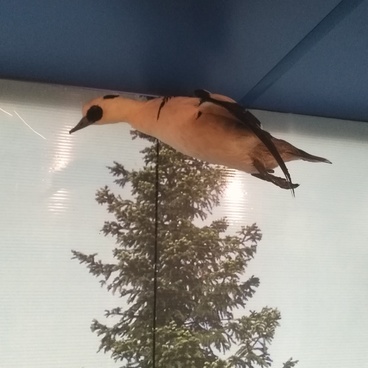It is customary for northern ethnic groups to make two types of cradles for babies — for the day and for the night. The day cradle is called khatl’evan ontyp in the Khanty language. It is made from wood: The bottom and the head board are made of cedar, and the sides are made of birch because it bends well. The ends of the cradle sides fit into the holes in the back part of the head board. They are fixed with rovduga — a special rope made of deer or elk skin. The sides are made from birch boards bent to repeat the shape of the bottom. They are fixed to the bottom with rovduga or with cedar root. The side top and the edges of the head board have holes for belts. The head board is covered with a piece of deer skin. Sometimes a cross is carved in the top part, as the Khanty believe that it protects the baby from evil spirits.
Using belts, a cradle can be attached to the ceiling, or in summertime, to a pole inserted into the ground at an angle. It is located so that adults can always see the baby. A baby is always in a sitting position in that cradle.
One essential element of a cradle are birch bark inserts that are replaced with larger ones as the baby grows. The inserts are made from two layers of birch bark sewn together and filled with birch dust prepared during the berry picking season. People pick up chips from an old birch or stub, crush them into dust and put it into specially sewn cotton bags. Bags hang inside for a few days to dry and then are removed to a granary.
When the birch dust gets wet, it gets replaced, but it is not thrown away. The trash is taken to a special “baby place, ” as the Khanty call it. It is usually located at the same distance as a lavatory for adults, but a little aside. The dust is always disposed of under a live tree: a birch if the baby in the cradle is a girl or a pine tree if it is a boy.
The birch bark plate for the baby”s legs is made of two layers of birch bark sewn together in a crisscross manner with a tendon thread. The plate is used to hold the legs in a certain position: The baby cannot bend them, so they grow straight.
Using belts, a cradle can be attached to the ceiling, or in summertime, to a pole inserted into the ground at an angle. It is located so that adults can always see the baby. A baby is always in a sitting position in that cradle.
One essential element of a cradle are birch bark inserts that are replaced with larger ones as the baby grows. The inserts are made from two layers of birch bark sewn together and filled with birch dust prepared during the berry picking season. People pick up chips from an old birch or stub, crush them into dust and put it into specially sewn cotton bags. Bags hang inside for a few days to dry and then are removed to a granary.
When the birch dust gets wet, it gets replaced, but it is not thrown away. The trash is taken to a special “baby place, ” as the Khanty call it. It is usually located at the same distance as a lavatory for adults, but a little aside. The dust is always disposed of under a live tree: a birch if the baby in the cradle is a girl or a pine tree if it is a boy.
The birch bark plate for the baby”s legs is made of two layers of birch bark sewn together in a crisscross manner with a tendon thread. The plate is used to hold the legs in a certain position: The baby cannot bend them, so they grow straight.

